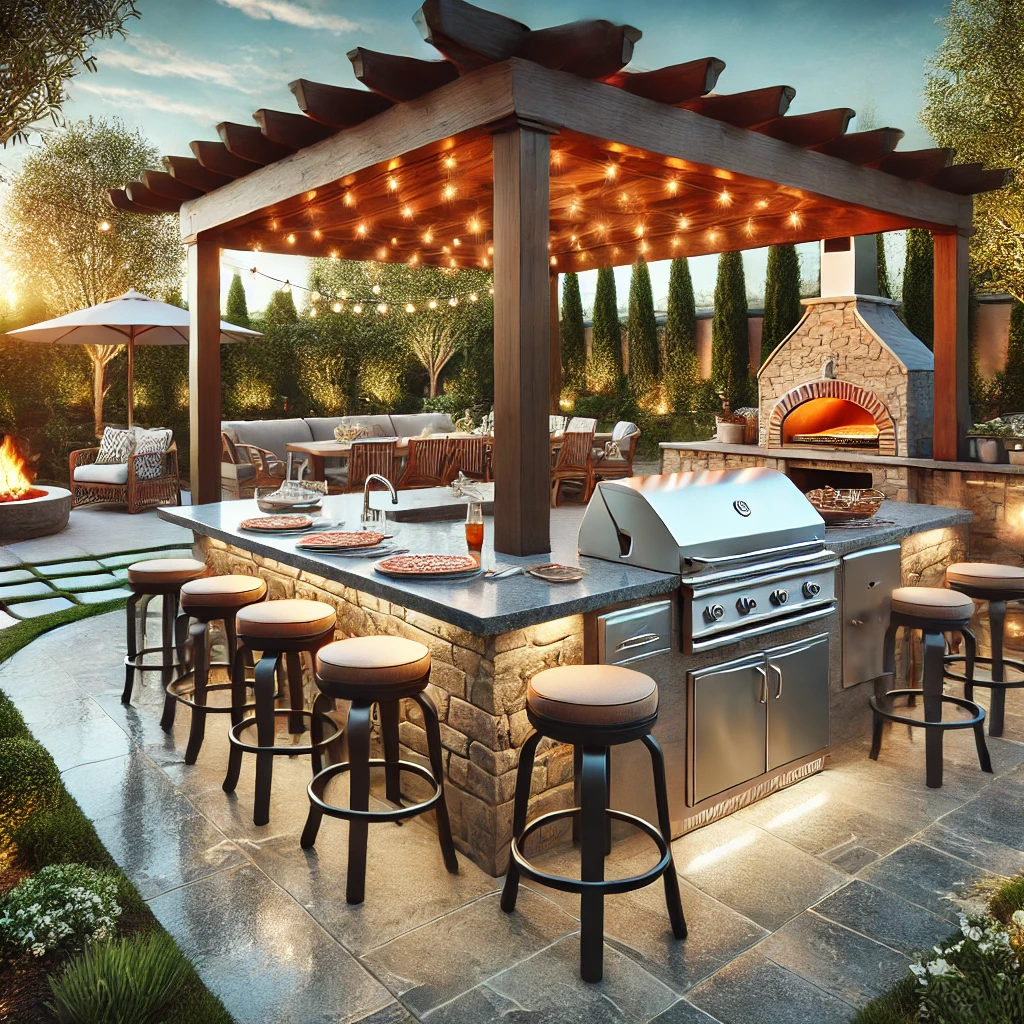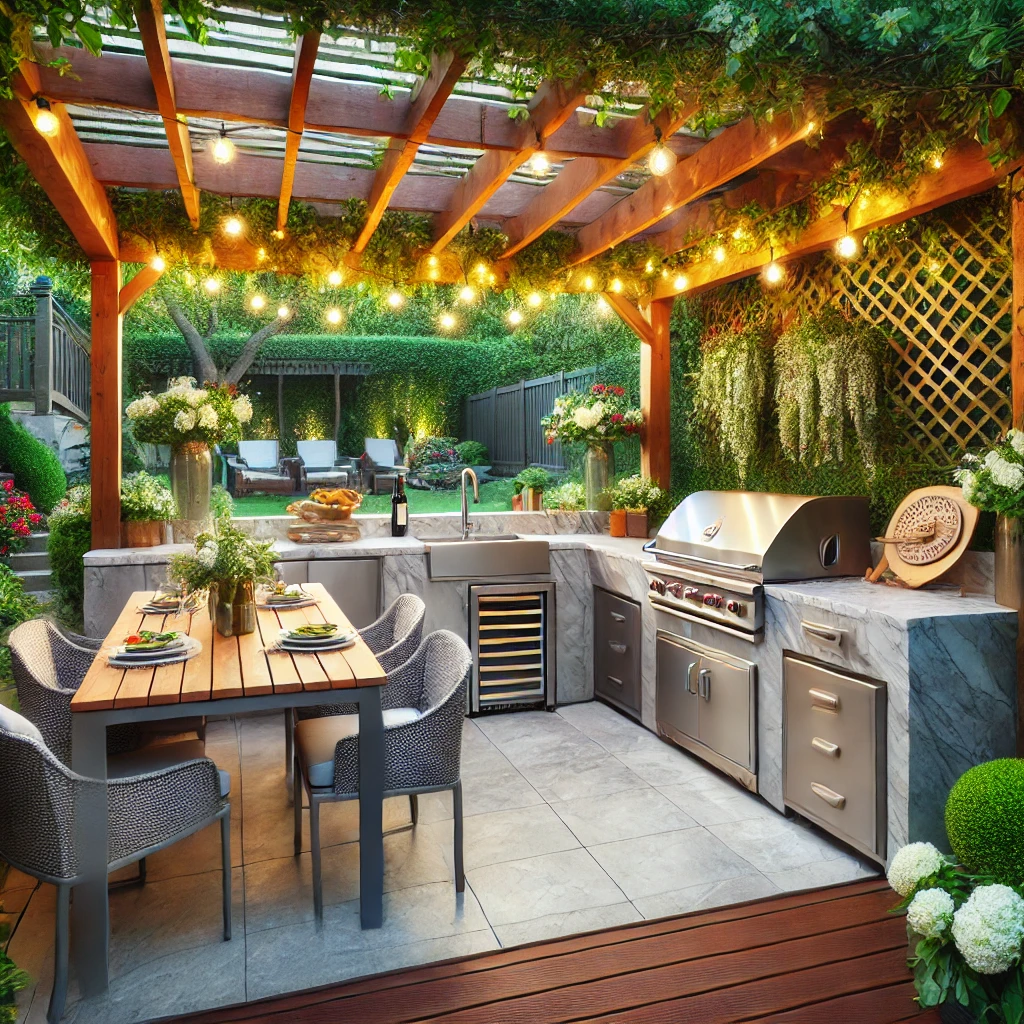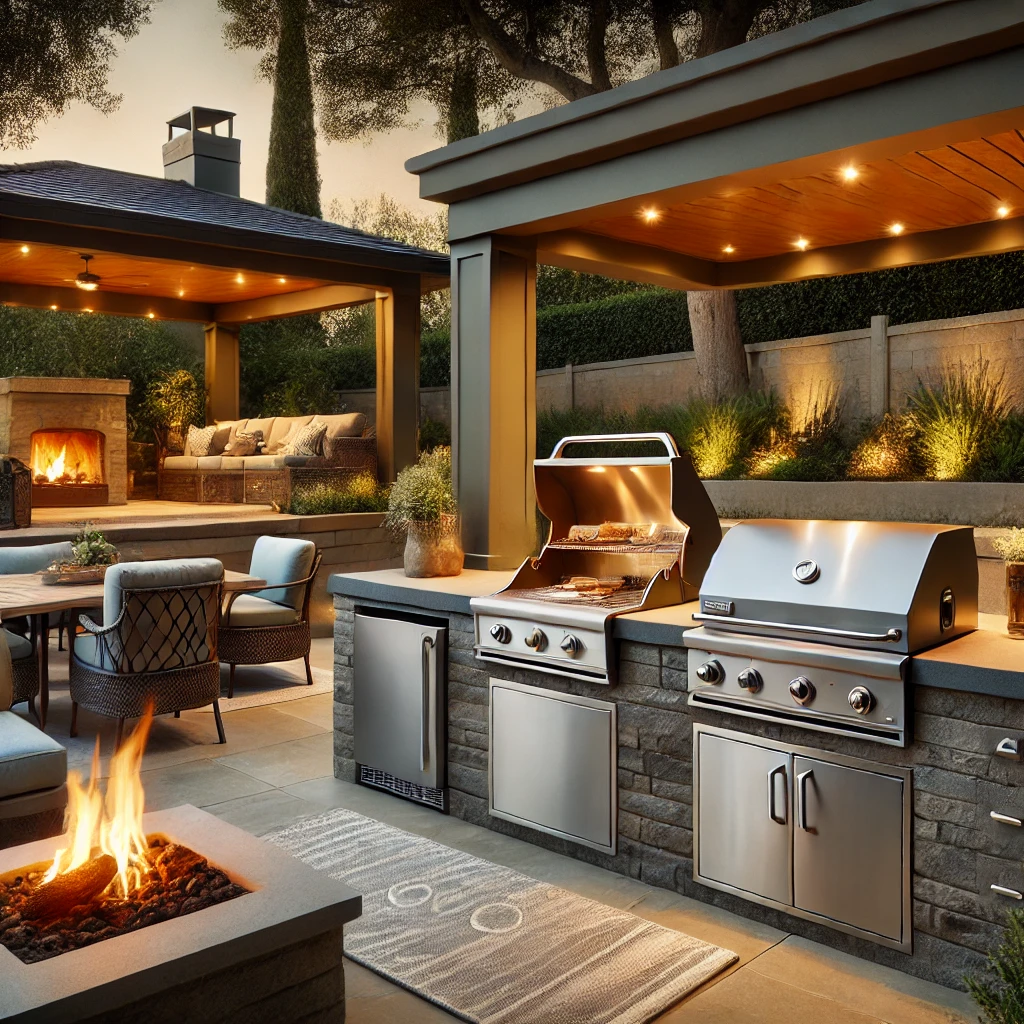Introduction to Outdoor Kitchens
Outdoor kitchens are a rapidly growing trend for homeowners looking to enhance their outdoor living experience. These spaces provide a dedicated area for cooking and dining while allowing you to enjoy the fresh air and natural surroundings. Unlike traditional indoor kitchens, outdoor kitchens are designed to withstand the elements, making them durable and long-lasting. They combine functionality with aesthetics, offering a seamless blend of practicality and visual appeal. From small setups with a grill and counter to expansive designs with sinks, refrigerators, and pizza ovens, these kitchens cater to various lifestyles and preferences. Transforming backyards into versatile living areas, outdoor kitchens create a hub for socializing, whether for family dinners or large gatherings.
The versatility of outdoor kitchens makes them suitable for any size or style of backyard. For example, a compact kitchen with a built-in grill and a small prep station is ideal for limited spaces, while larger yards can accommodate elaborate designs with bar seating, fire pits, and outdoor lighting. They also allow homeowners to expand their living space without costly home additions, maximizing the usability of outdoor areas. Beyond functionality, these kitchens enhance property value and curb appeal, making them a wise investment. By combining convenience and beauty, outdoor kitchens redefine how we use and enjoy our outdoor spaces.
Benefits of Outdoor Kitchens
Outdoor kitchens are much more than an area for cooking; they bring added functionality and charm to your home. By expanding your living space, they create an ideal environment for hosting friends and family in a relaxed, open-air setting. From casual family barbecues to elegant dinner parties, outdoor kitchens transform gatherings into memorable experiences. They also enhance the overall value of your property, as many homebuyers view them as a desirable feature. Furthermore, outdoor kitchens help keep your home cooler by relocating heat-generating activities like grilling and baking outside, especially during the summer months. This not only improves indoor comfort but can also reduce energy costs associated with air conditioning.
Another major advantage of outdoor kitchens is their ability to streamline the cooking and entertaining process. By equipping the space with essentials like grills, refrigerators, sinks, and countertops, homeowners can avoid frequent trips indoors, keeping everything they need within arm’s reach. This convenience allows for a smoother and more enjoyable cooking experience. Additionally, keeping strong cooking odors, such as fish or grilled meats, outside prevents them from lingering in your home. The versatility of outdoor kitchens, combined with their practicality, makes them a valuable addition that improves both the functionality and aesthetic appeal of your outdoor space.
Essential Components of an Outdoor Kitchen
Outdoor kitchens are highly customizable, but several key components form the foundation of a functional and efficient setup. Grills are the centerpiece of most outdoor kitchens, providing versatile cooking options from barbecuing to smoking. Countertops offer essential prep space, ensuring ingredients and utensils are within easy reach while cooking. Sinks with running water simplify cleaning and enhance convenience, especially for tasks like washing produce or rinsing cookware. Storage cabinets protect utensils, cookware, and supplies from the elements, ensuring everything stays organized and accessible. Refrigeration units, such as mini-fridges or wine coolers, keep beverages and perishables chilled, reducing trips indoors. Each of these components is selected to match the homeowner’s specific needs, maximizing functionality and enjoyment.
The design of outdoor kitchens can be tailored further with optional additions that suit individual lifestyles and entertaining preferences. For instance, homeowners who enjoy pizza can incorporate a wood-fired oven, while those who frequently host guests might prioritize bar seating or ice makers. Materials for these components should be durable and weather-resistant, such as stainless steel for appliances and granite for countertops, to withstand outdoor conditions. Lighting and electrical outlets are also important for evening use and powering appliances. By thoughtfully combining these elements, outdoor kitchens can become both practical and luxurious extensions of the home.
Choosing the Right Location
Choosing the ideal location for outdoor kitchens is a crucial step in maximizing functionality and comfort. Proximity to the house is often a top priority, as it allows for easy access to indoor amenities like the main kitchen or dining room. This is particularly useful for transporting ingredients, dishes, and beverages. Additionally, understanding the wind direction in your yard is essential to avoid smoke from grills or pizza ovens blowing into seating areas or back toward the house. Sun exposure is another key factor; placing the kitchen in a shaded area or adding a pergola can keep the space comfortable during the hottest parts of the day. A well-thought-out location ensures seamless use and enjoyment.
Another important consideration for outdoor kitchens is accessibility to utilities such as water, gas, and electricity. Placing the kitchen near existing lines can reduce installation costs and ensure reliable functionality. For example, locating a sink close to an outdoor water source simplifies plumbing requirements. The layout of your yard and its traffic flow should also guide the placement. A centralized location can create a natural hub for socializing, while a corner setup might be ideal for smaller yards to conserve space. Taking these factors into account ensures the outdoor kitchen not only looks great but also meets your practical needs.

Materials for Durability and Style
The choice of materials for outdoor kitchens is critical to ensuring they withstand the elements while maintaining functionality and aesthetics. Stainless steel is a top choice for appliances and cabinetry due to its resistance to rust, corrosion, and temperature fluctuations. It is also easy to clean, making it ideal for outdoor use. Granite countertops are another popular option, as they provide a durable, scratch-resistant surface that can handle food prep and heavy use. Granite’s natural patterns and colors complement outdoor settings beautifully, adding a touch of elegance. Stone, such as limestone or slate, is frequently used for bases, walls, or decorative elements, offering both strength and a rustic charm that enhances the overall design.
In addition to durability, the materials used in outdoor kitchens must require minimal maintenance to handle year-round exposure to sun, rain, and frost. Powder-coated steel or aluminum is an excellent choice for structures, as it resists fading and wear. For flooring, materials like concrete pavers or natural stone ensure a non-slip and weather-resistant surface that blends seamlessly with the kitchen’s aesthetic. Using high-quality, weather-resistant materials not only extends the life of the outdoor kitchen but also enhances its visual appeal, creating a space that is both functional and stylish for years to come.
Appliances for Outdoor Kitchens
Appliances are the heart of outdoor kitchens, providing the tools needed for cooking and entertaining in the open air. Grills are the centerpiece, available in gas, charcoal, or hybrid options to suit different cooking preferences. Gas grills offer convenience and precise temperature control, while charcoal grills deliver a smoky flavor ideal for barbecues. Pizza ovens are a popular addition, enabling homeowners to bake authentic, wood-fired pizzas and other dishes like bread or roasted vegetables. Smokers are perfect for slow-cooking meats, infusing rich flavors into ribs, brisket, and more. Wine coolers, often integrated into outdoor setups, allow easy access to chilled beverages, enhancing the dining experience. These appliances transform outdoor kitchens into versatile culinary spaces.
Modern outdoor kitchens also include appliances that go beyond traditional cooking methods. Side burners are great for preparing sauces or side dishes, complementing the main grill. Ice makers and beverage centers provide convenience during gatherings, ensuring guests stay refreshed without trips indoors. Outdoor refrigerators keep ingredients fresh and accessible, while built-in sinks simplify cleanup. For entertainment, some setups include outdoor TVs or sound systems, making the space ideal for hosting parties or game nights. With the right combination of appliances, outdoor kitchens offer endless possibilities for preparing and enjoying meals outdoors.
Designing for Comfort and Functionality
Creating an inviting and efficient space is essential when planning outdoor kitchens. Comfortable seating is a key element, encouraging guests to relax and enjoy the area. Options like cushioned chairs, built-in benches, or bar stools paired with a countertop make the space ideal for casual dining or entertaining. Proper lighting is equally important for functionality and ambiance, with task lighting for cooking areas and softer, decorative lighting for dining spaces. Additionally, a well-planned layout ensures a smooth workflow, with the grill, prep area, and sink arranged in a convenient triangle for easy access. This ergonomic approach minimizes movement, making the cooking experience more enjoyable while allowing hosts to stay engaged with their guests.
Beyond seating and lighting, outdoor kitchens can include features that maximize comfort and convenience. Adding shade elements like pergolas, umbrellas, or retractable awnings ensures protection from the sun and light rain, extending usability throughout the day and across seasons. Fans or patio heaters can further enhance the space, keeping it comfortable in both hot and cooler weather. Incorporating storage cabinets and counter space reduces clutter and provides room for essentials, keeping the area organized. By blending comfort with thoughtful design, outdoor kitchens can become the centerpiece of your backyard, offering both practicality and a welcoming atmosphere for gatherings.

Incorporating Shade and Shelter
Incorporating shade and shelter is essential for making outdoor kitchens comfortable and functional in various weather conditions. Structures like pergolas are a popular choice, offering partial shade while maintaining an open and airy feel. Pergolas can be enhanced with climbing plants, such as ivy or wisteria, to provide natural cooling and add a touch of greenery. Retractable awnings are another versatile option, allowing homeowners to control the amount of sunlight or protection from rain as needed. For smaller spaces, umbrellas can provide a portable and flexible solution, offering targeted shade for specific areas like seating or cooking stations. These features ensure that outdoor kitchens remain inviting and practical, regardless of the time of day or season.
Beyond shade, incorporating shelter into outdoor kitchens can greatly enhance their usability. Enclosed or partially enclosed structures, such as pavilions, protect against wind and heavier rain, making the space functional even in less-than-ideal weather. Transparent materials like polycarbonate roofing allow natural light to filter through while shielding the area from precipitation. Additionally, features like roll-down screens or curtains can block wind and insects, creating a cozy and enclosed environment. By thoughtfully integrating shade and shelter elements, outdoor kitchens can become versatile spaces that cater to comfort and usability all year round.
Outdoor Kitchen Safety Tips
Ensuring safety is a top priority when designing and using outdoor kitchens, as they involve open flames, heat, and electrical components. One of the most critical safety measures is using fire-resistant materials, such as stainless steel for appliances and non-combustible stones or tiles for countertops and surrounds. These materials reduce the risk of fire and withstand high temperatures. Proper ventilation is equally important, especially for enclosed or semi-enclosed spaces with grills or burners. Adequate airflow prevents the buildup of harmful gases like carbon monoxide, making the kitchen safe for extended use. Additionally, maintaining a safe distance between heat-producing appliances and flammable objects, such as outdoor furniture or overhanging foliage, minimizes potential fire hazards.
Another essential safety consideration in outdoor kitchens is the placement and connection of utilities. Gas lines should be installed and inspected by licensed professionals to ensure no leaks or pressure issues. Electrical outlets should be weatherproof and equipped with ground fault circuit interrupters (GFCIs) to prevent electrical shocks in damp conditions. Installing appliances at the correct height also enhances safety and ergonomics, reducing the risk of accidental burns or spills. Fire extinguishers and a first-aid kit should always be kept nearby for emergencies. By prioritizing these safety features, outdoor kitchens can provide a secure environment for cooking and entertaining while ensuring peace of mind for homeowners.
Maintenance and Upkeep
Proper maintenance is essential to keep outdoor kitchens functional and visually appealing for years to come. Regular cleaning is the first step, as outdoor environments expose kitchens to dirt, grease, and weather elements. Stainless steel surfaces should be wiped down with non-abrasive cleaners to prevent corrosion and maintain their shine. Countertops made of materials like granite or stone benefit from periodic sealing to protect them from stains, moisture, and UV damage. Cleaning grills, including burners and grates, after each use ensures optimal performance and prevents residue buildup. These simple yet crucial tasks help preserve the overall condition of outdoor kitchens, allowing homeowners to enjoy their investment without interruption.
Seasonal upkeep is another critical aspect of maintaining outdoor kitchens, particularly in regions with harsh winters. Winterizing appliances such as refrigerators, sinks, and grills protects them from freezing temperatures that could cause damage. Draining water lines and turning off gas connections before winter helps prevent leaks and cracking. Covering appliances and furniture with weatherproof covers reduces exposure to snow, rain, and frost, extending their lifespan. Additionally, inspecting for wear and tear, such as loose pavers or damaged seals, ensures that minor issues are addressed before they escalate. With consistent care, outdoor kitchens remain a functional and attractive centerpiece of outdoor living spaces.

Popular Trends in Outdoor Kitchens
Outdoor kitchens are evolving to meet modern needs, with homeowners increasingly incorporating smart appliances into their designs. Smart grills and smokers, equipped with Wi-Fi or Bluetooth connectivity, allow users to control temperatures and monitor cooking progress directly from their smartphones. These innovations bring convenience and precision to outdoor cooking, making it more enjoyable and efficient. Eco-friendly materials are another growing trend, with options like recycled stone, sustainably sourced wood, and energy-efficient appliances gaining popularity. Solar-powered lighting and water-saving fixtures further enhance sustainability, aligning outdoor kitchens with environmentally conscious lifestyles. These trends showcase a shift towards designs that are not only functional but also forward-thinking and sustainable.
In addition to technology and eco-friendliness, multi-functional features are becoming staples in outdoor kitchens. Built-in fire pits or fireplaces add warmth and create a cozy atmosphere, allowing the space to be used year-round. Bar areas with seating encourage social interaction, transforming outdoor kitchens into hubs for entertaining. Some designs incorporate pizza ovens or modular cooking stations to expand meal options, catering to diverse culinary preferences. Beverage centers, complete with wine coolers and ice makers, add an extra layer of convenience for gatherings. These popular trends highlight the desire for outdoor kitchens that combine practicality, comfort, and luxury, making them a standout feature in modern backyards.
Why Invest in an Outdoor Kitchen?
Investing in outdoor kitchens offers numerous benefits that go beyond functionality. They serve as an extension of your living space, providing a unique area for cooking, dining, and entertaining in the open air. By creating an inviting environment, outdoor kitchens encourage quality time with family and friends, whether during casual weekday dinners or large weekend gatherings. The ability to prepare meals outdoors reduces the strain on your indoor kitchen and minimizes heat build-up inside the home during warmer months. Additionally, an outdoor kitchen can be customized to suit your lifestyle, from simple setups with a grill and countertop to elaborate designs featuring pizza ovens, bar areas, and outdoor fireplaces. This flexibility makes them a valuable addition to any home.
Beyond enhancing your daily life, outdoor kitchens are a smart financial investment. They can significantly boost your property’s value and appeal to potential buyers, especially in regions where outdoor living is highly desirable. According to real estate experts, well-designed outdoor kitchens offer a high return on investment by increasing functionality and curb appeal. They also reduce wear and tear on indoor spaces, lowering maintenance costs over time. The lasting memories created by hosting friends and family in this outdoor oasis further highlight the personal and financial rewards of this addition, making it a worthwhile investment for homeowners seeking to improve both their lifestyle and property.

